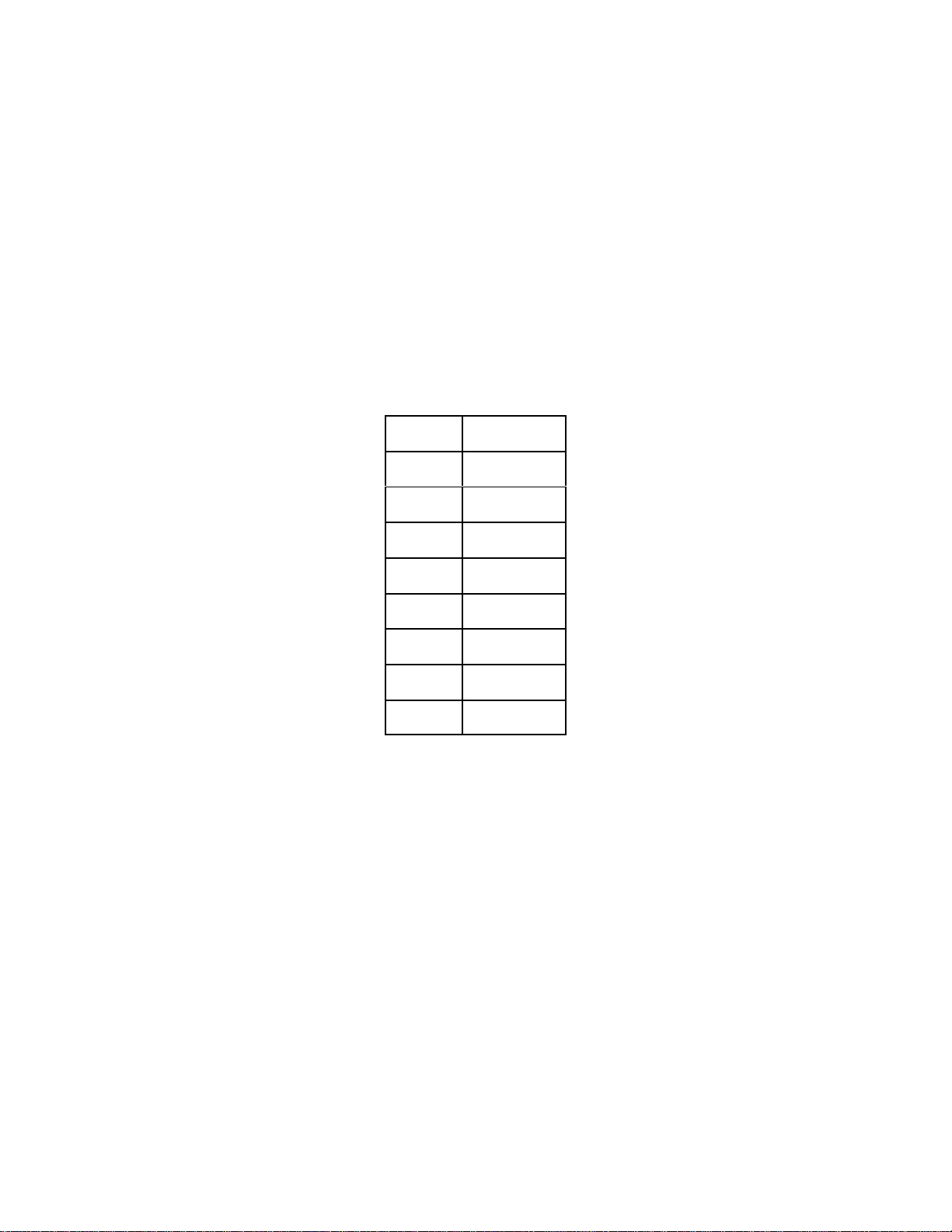
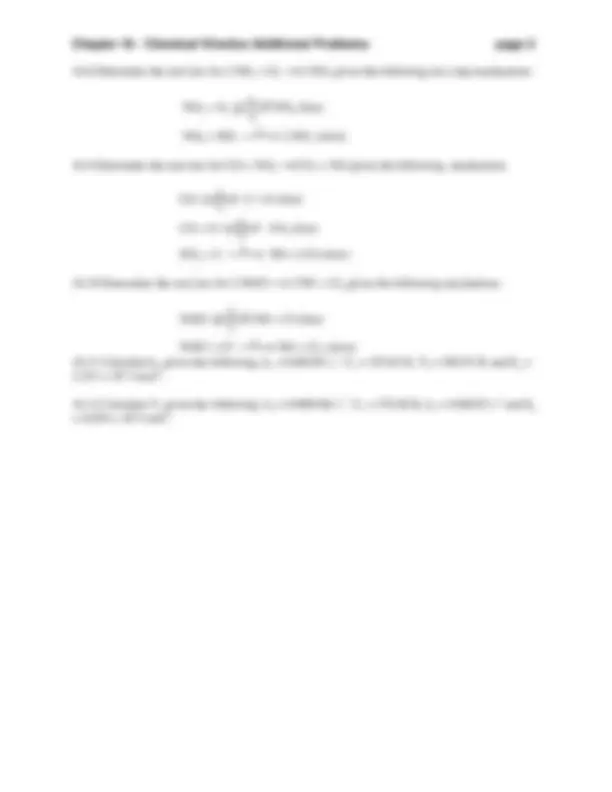
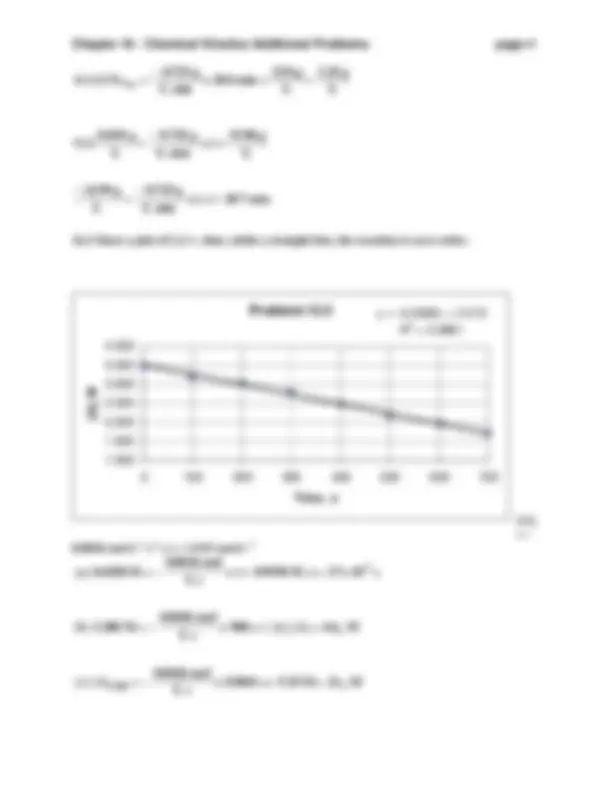
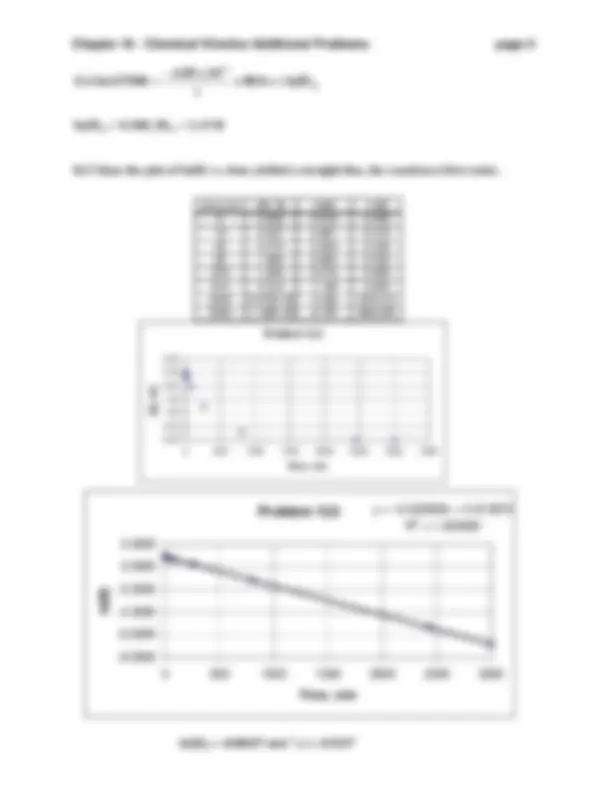
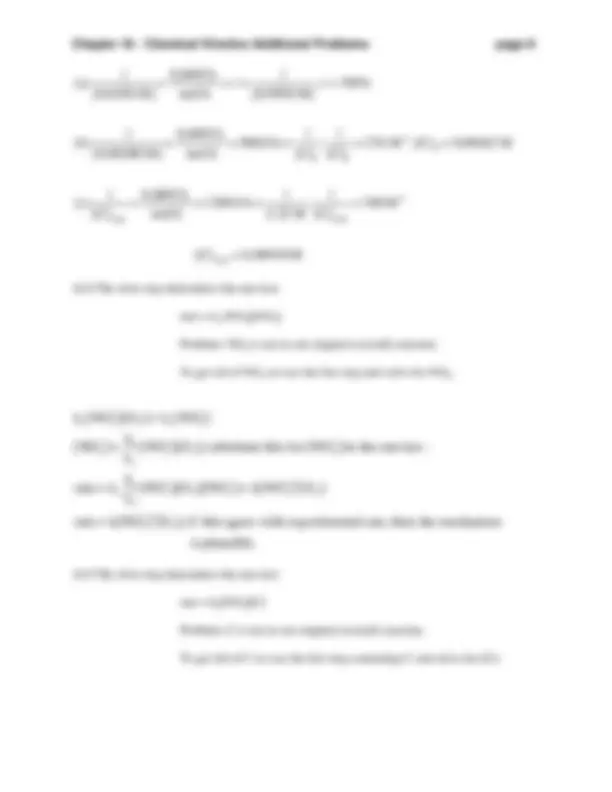
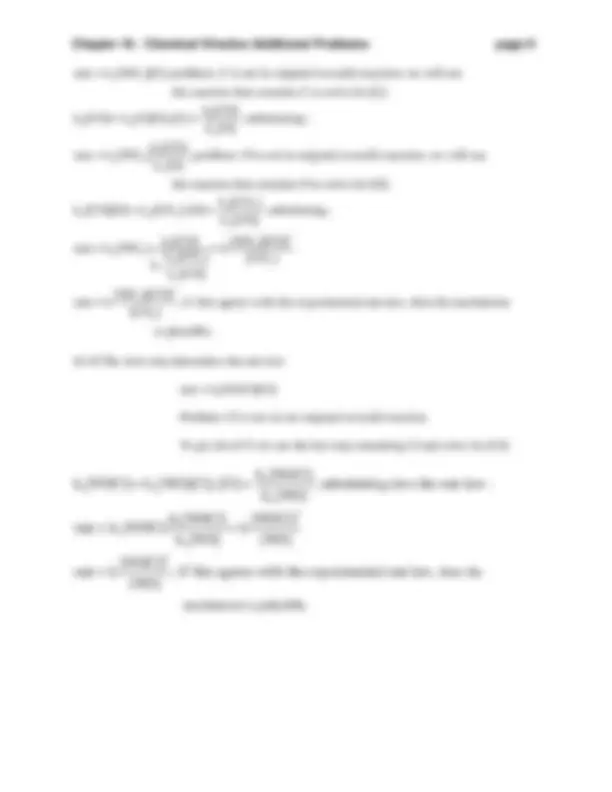
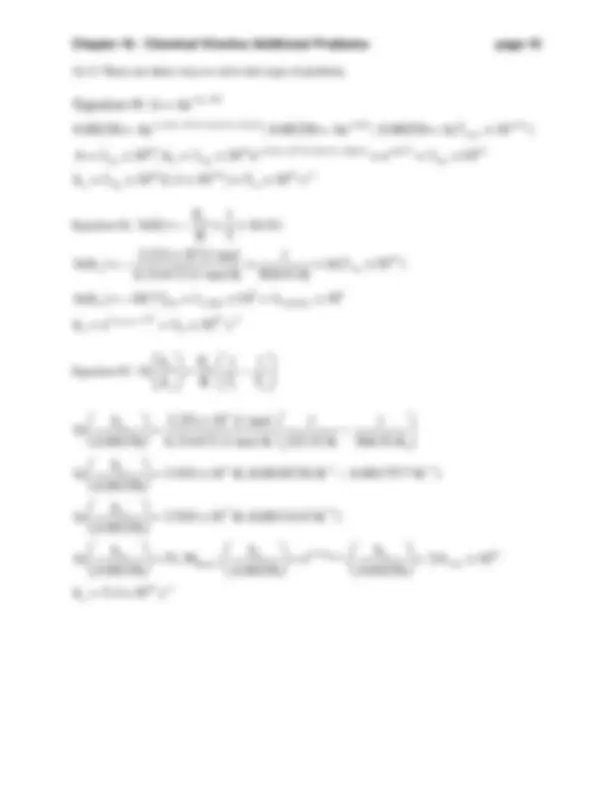


Study with the several resources on Docsity

Earn points by helping other students or get them with a premium plan


Prepare for your exams
Study with the several resources on Docsity

Earn points to download
Earn points by helping other students or get them with a premium plan
Community
Ask the community for help and clear up your study doubts
Discover the best universities in your country according to Docsity users
Free resources
Download our free guides on studying techniques, anxiety management strategies, and thesis advice from Docsity tutors
Additional problems and solutions related to chemical kinetics. It includes various reaction rates, orders, and mechanisms. Students can use this document to practice solving chemical kinetics problems.
Typology: Exams
1 / 11

This page cannot be seen from the preview
Don't miss anything!







Chapter 16 -Chemical Kinetics Additional Problems
Instructor: Sherman Henzel
16.1 The conversion of CO to CO 2 in a catalytic converter is shown to be zero order with respect
to CO. If the initial concentration of CO is 25.0 g/L, what will be its final concentration after
30.0 minutes? k for this reaction is 0.725 g/L-min.
16.2. How many minutes will it take to reduce the concentration of CO from 15.00 g/L to 0.
g/L in a catalytic converter?
16.3 Given the data below determine the rate for the process A ) products.
time, s [A], M
0 3.
100 3.
200 3.
300 2.
400 2.
500 2.
600 1.
700 1.
(a) How long will it take the concentration of A to decrease from 0.9950 M to 0.0350 M?
(b) If the concentration of A is 2.280 M after 900 s, what was the initial concentration A?
(c) Starting with [A] = 5.25 M, what is [A] after 1200.0 s?
16.4 B ) products is a first order process. If after 80.0 s the concentration of B is 0.7500 M,
what was the initial concentration of B? k = 6.85 x 10
16.5 Given the data below determine the rate for the process B ) products.
time, min [B], M
0 2.
10.0 2.
30.0 2.
90.0 1.
270.0 1.
810.0 0.
2430.0 0.
3000.0 0.
(a) How long will it take the concentration of B to decrease from 0.9950 M to 0.0350 M?
(b) If the concentration of B is 2.280 M after 900.0 min, what was the initial
concentration B?
(c) Starting with [B] = 5.25 M, what is [B] after 1200.0 min?
16.6 C ) products is a second order process. If the initial concentration of C is 0.3750 M, what
will be the concentration of C after 1500.0 seconds? k = 0.00125 L mol
16.7 Given the data below determine the rate for the process C ) products.
time, h [C], M
0 0.
0.50 0.
1.50 0.
5.50 0.
8.50 0.
12.50 0.
15.50 0.
25.50 0.
(a) How long will it take the concentration of A to decrease from 0.9950 M to 0.0350 M?
(b) If the concentration of A is 0.002280 M after 900.0 h, what was the initial
concentration A?
(c) Starting with [A] = 5.25 M, what is [A] after 1200.0 h?
Problem 13.3 (^) y = -0.0026x + 3.
R
2 = 0.
0 100 200 300 400 500 600 700
Time, s
[A], M
1 1 CO
0 725 g
L min
x 30 0 min
25 0 g
L
3 25 g
L
. .
.. . =
−
1 2
0 010 g
L
0 725 g
L min
x t
15 00 g
L
14 99 g
L
0 725 g
L min
x t t 20 7 min
... .. ;.
=
−
16.3 Since a plot of [A] v. time yields a straight line, the reaction is zero order.
[A] (^) t
= -
0.0026 mol L
- s - x t + 3.515 mol L -
( ).
.
. ;.
( ).
. [ ];[ ].
( ) [ ]
.
...
a 0 0350 M
0 0026 mol
L s
x t 0 9950 M t 3 7x 10 s
b 2 280 M
0 0026 mol
L s
x 900 s A A 4 6 M
c A
0 0026 mol
L s
x 1200 0 s 5 25 M 2 1 M
2
2
1200 3
= − + =
= − + =
= − + =
time,min [B], M ln[B] 1/[B]
0 2.500 0.916 0.
10 2.437 0.891 0. 30 2.315 0.839 0. 90 1.984 0.685 0. 270 1.245 0.219 0.
810 0.312 -1.164 3. 2430 4.873E-03 -5.324 205. 3000 1.128E-03 -6.787 886.
Problem 13.
0 500 1000 1500 2000 2500 3000 3500
Time, min
[B], min
Problem 13.5 y = -0.002568x + 0.
R
2 = 1.
-8.
-6.
-4.
-2.
0 500 1000 1500 2000 2500 3000
Time, min
ln[B]
1 4 ln 0 7500
6 85 x 10
s
x 80 0 s ln B
ln B 0 360 B 1 3 M
3
0
0 0
6
4
. (. )
.
. [ ]
[ ]. ; [ ].
=
−
= =
−
16.5 Since the plot of ln[B] vs. time yielded a straight line, the reaction is first order.
ln[B] (^) t = -0.00257 min
- x t + 0.
Problem 13.
0
1
0 5 10 15 20 25 30
Time, h
[C], M
Problem 13.
-1.
-1.
-0.
-0.
-0.
-0.
0
0 5 10 15 20 25 30
Time, h
ln[C]
Problem 13.7 (^) y = 0.0895x + 1.
R^2 = 1
0
1
2
3
4
0 5 10 15 20 25 30
time, h
1/[C], M
-
1/[C] (^) t = 0.0895 L mol
- h - + 1.053 M -
1 0 0 0
1
1200 1200
1200
(a) x t ; t 308 h [0.0350 M] mol h [0.9950 M]
(b) x 900.0 h ; 276 M ; [C] 0.00362 M [0.00280 M] mol h [C] [C]
(c) x 1200.0 h ; 108 M [C] mol h 5.25 M [C]
−
−
16.8 The slow step determines the rate law:
rate = k 3 [NO
4 ][NO - 2 ]
Problem: NO
4 is not in our original (overall) reaction.
To get rid of NO
4 we use the fast step and solve for NO - 4 :
1 2 2 2 4
1 4 2 2 4 2
1 2 3 2 2 2 2 2 2 2 2 2
k [NO ][O ] k [NO ]
k [NO ] [NO ][O ]; substitute this for [NO ] in the rate law : k
k rate k [NO ][O ][NO ] k[NO ] [O ] k
rate k[NO ] [O ]; if this agees with exp erimental rate, then the mechanism
is plausible.
− −
− − −
− − −
−
16.9 The slow step determines the rate law:
rate = k 5 [NO 2 ][C]
Problem: C is not in our original (overall) reaction.
To get rid of C we use the fast step containing C and solve for [C]:
16.11 There are three ways to solve this type of problem.
a
5
5
E / RT
3.251 x 10 /8.314472 x 325.62 120.1 53) 077
49 49 3.251 x 10 / 8.314472 x 568.91 68.73 49 65 2 65 65
49 30 19 2 65 2
−
− − −
− −
−
− 1
Equation #2:
E (^) a 1 ln(k) x ln(A) R T
1 4533621
5 49 2 45
2 1 2 879 14065 4533621
3.251 x 10 J / mol 1 ln(k ) x ln(3. x 10 ) 8.314472 J / mol K 568.91 K
ln(k ) 68.72 1. x 10 4. x 10
k e 4. x 10 s
−
Equation #3:
2 a
1 1 2
k E 1 1 ln k R T T
5 2
2 4 1 1
2 4 1
2 2 82444
k 3.251 x 10 J / mol 1 1 ln 0.00258 8.314472 J / mol K 325.52 K 568.91 K
k ln 3.910 x 10 K (0.0030720 K 0.0017577 K )
k ln 3.910 x 10 K (0.0013143 K )
k k ln 51.38 ; 0.00258 0.
− −
−
51.38 82444 2 22 7793
19 1 2
k e ; 2.0 x 10 0258 0.
k 5.4 x 10 s
−
16.12 There are three ways to solve this type of problem.
a
4
5
E / RT
8.654 x 10 / 8.314472 x 278.96 37.31 17) 5046
13 13 3.251 x 10 / 8.314472 x 568.91 68.73 49 7578 2 7578 65
13 8. 7578
Equation #1: k Ae
0.00186 Ae ; 0.00186 Ae ; 0.00186 A(62. x 10 )
A 2.9 x 10 ; k 2.9 x 10 e e 3. x 10
0.00325 2.9 x 10 (e
−
− − −
− −
−
4
4
654 x 10 / 8.314472 x T
13 8.654 x 10 / 8.314472 x T 7578 4 4
0241 7531
2 311154 320
ln(0.00325) ln(2.9 x 10 ) ln(e )
8.654 x 10 8.654 x 10 5.729 31. ; 36. 8.314472 x T 8.314472 x T
0.0035 ; T 2.8 x 10 K T
− = +
Equation #2:
E (^) a 1 ln(k) x ln(A) R T
4 13 7578
4 91 8358 4112
4 1 8358 31125
2 319
8.654 x 10 J / mol 1 ln(0.00325) x ln(2.9 X 10 ) 8.314472 J / mol K T
5.72 1.040 x 10 K x 31. T
1 1 36.75 1.040 x 10 K x ; 0.0035 K T T
T 2.8 x 10 K
−
Equation #3:
2 a
1 1 2
k E 1 1 ln k R T T
4
2
4 1
2
1 1 1 1
2 2
2
0.00325 8.654 x 10 J / mol 1 1 ln 0.00186 8.314472 J / mol K 278.96 K T
0.558 1.040 x 10 K 0.0035847 K T
−
− − − −